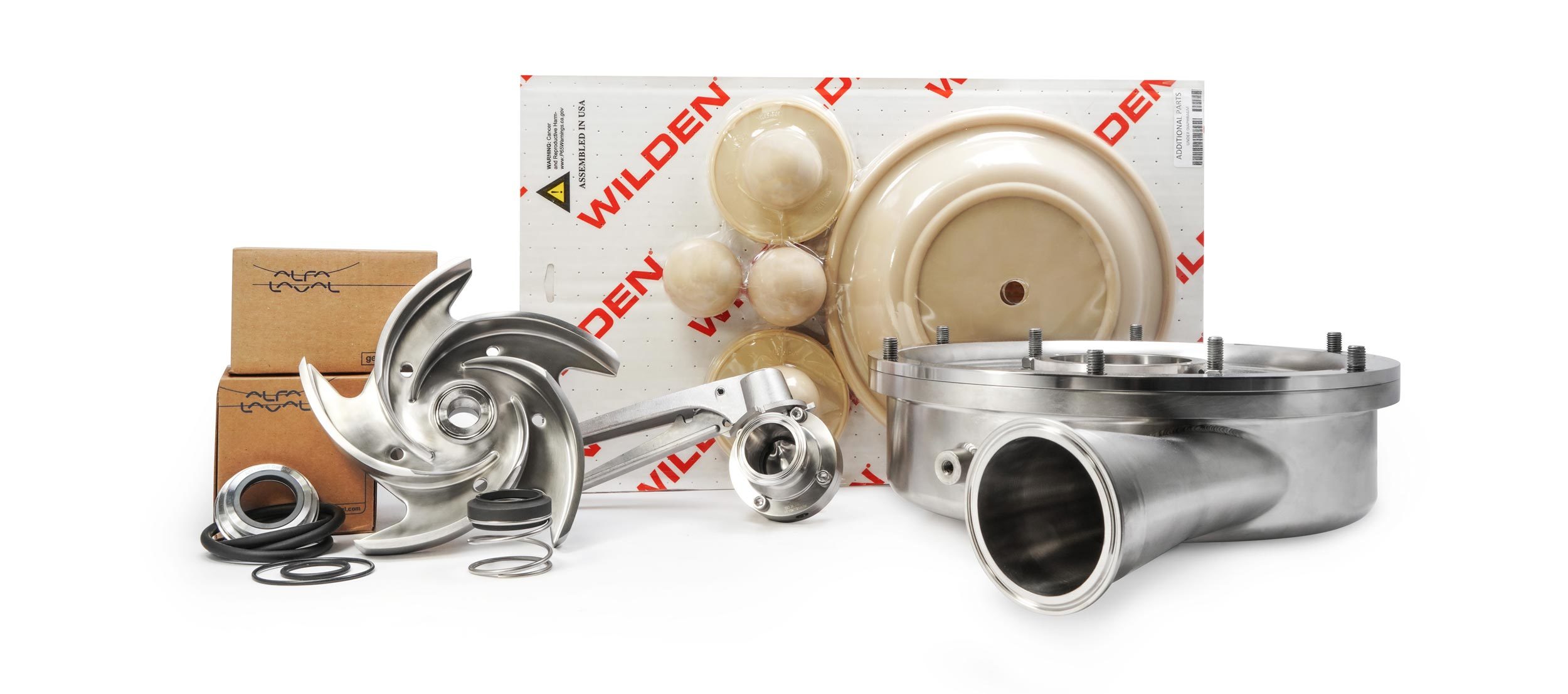Most Common Styles of Pump Seals
By their very design, hygienic fluid pumps need seals to operate properly and prevent leaks between the pump's rotating shaft(s) and the surrounding atmosphere. If not properly selected and fitted, pump seals are subject to frequent failure under operating conditions, requiring time-consuming replacement.
Additionally, in sanitary processing applications a worn or leaking seal can also expose products to outside contaminants, potentially affecting product quality. Thus, in many respects, a pump is only as good as its seal.
There are two broad categories of pump seals: o-rings and mechanical seals.
- O-rings are simple and quite prevalent and are found in both single and double configurations
- Mechanical seals are more complex

Single mechanical seals are used in a variety of pumps, including those from CSI supplier Alfa Laval. Single mechanical seals may or may not include what’s called a “flush” feature, used to maintain proper lubrication of the seal components while the pump is in operation.
Then there are double mechanical seals, found in pumps used in more demanding pumping operations. All double mechanical seals require a flush.
This article will focus on these two common types of seals found in fluid pumps used in the hygienic processing industries, including the food, dairy, beverage, pharmaceutical, and biotechnology industries.
We'll describe:
- Each type of seal
- For what types of applications each is used
- Seal design, failure modes, and installation
One of the critical areas spare parts providers must help customers with is consolidating the number of seal configurations in their facility. This allows them lower the number of spare parts on hand and can help their maintenance teams be more efficient
~ Michael David, Manager of Pump and Heat Exchanger Technology

O-Rings
O-rings are the most common variety of pump seals used in the liquid hygienic processing industries. They are inexpensive, reliable, and easy to install or remove. Depending on seal hardness, O-rings may be used in a variety of different operating temperatures and pressures in sanitary processing applications.
As shown to the left, O-rings are round rings, typically made of a rubber compound or thermoplastic, designed to be seated into a mechanical part and compressed on assembly to create a seal at the interface with a second part.
O-rings fit into a groove machined into the pump shaft which interfaces with a replaceable (i.e., wearable) sleeve. This seals against the pump’s body to create a leakproof interface between the shaft assembly and the housing.
O-rings are commonly used in the hygienic processing industries in applications where the pump seals require frequent replacement, either due to cleanliness requirements or wear. Their simplicity, cost, and ease of installation make it possible to replace O-rings on a pump daily in production operations or at the end of a shift.
Types of O-Ring Seals
In hygienic fluid processing, O-rings are used in both single and double configurations.
- Single O-rings use one ring on a machined rotating part — such as a pump shaft — to seal against the pump's housing.
- Double O-rings use two adjacent rings in separate machined grooves to provide an improved seal for use with challenging fluids, such as abrasives. A seal flush is required when using a double O-ring configuration.
Materials used to construct O-rings used in hygienic fluid pumps are chosen based on several factors, including chemical compatibility, application temperature, sealing pressure, O-ring hardness requirements, size, and cost.
Common materials used include:
- EPDM
- Viton
- BUNA
- Silicone

O-ring failures may be caused by several factors, including too high or low temperatures, chemical attack (due to incompatibility with the product or cleaning fluids), vibration, and abrasion. Because of this, selecting the appropriate material from which the O-ring is constructed is especially important. If chosen properly, O-ring materials can tolerate operating temperatures as low as -328°F, and as high as 482°F and still function correctly.
Mechanical Seals
Mechanical seals differ from O-rings in that they're designed for use in pump applications that will be in operation for more extended periods of time in-between seal replacement or service. They are also ideal for use in pumps that will be cleaned with some sort of automated process such as clean-in-place (CIP).

Different Types of Mechanical Seals
There are two basic types of mechanical seals—single seal and double seal. Additionally, single seals may be designed with what’s called a flush option as well. (Double seals always come with a flush).
As shown, mechanical seals contain several discrete components, including a stationary seal, a rotating seal, an O-ring for each, and a spring. These components rotate around the pump’s shaft which passes through the middle.
The spring is used to provide tension between the seal surfaces as they wear. It also provides tension on the seal when no product pressure is present. The two seals are machined using a process called lapping to achieve the necessary degree of surface flatness to achieve a leakproof operation.
As previously mentioned, mechanical seals are available in either single seal or double seal varieties. A single mechanical seal consists of a pair of sealing surfaces, while a double mechanical seal consists of two pairs.
Single mechanical seals are found in pumps used for simple duties such as pumping water, milk, animal fats, and beverages, as well as many other food processing applications. If the fluid to be pumped is more challenging in certain respects, then a double mechanical seal may be warranted to provide extra security. “Challenging” in this context includes fluids that are abrasive, such as crystalline sugar slurries.
Both single and double mechanical seals may also come with a flush. All types of mechanical seals generate heat from friction between the moving surfaces, and a cooling fluid — called a flush — circulates around the seal to remove the heat.
The flush provides constant lubrication when the product flow is not sufficient; the fluid flow is intermittent (e.g., entrained air in a CIP return pump); or the product is abrasive or sticky (sugar, chocolate, etc). This flush fluid may be the same as the fluid being pumped or an entirely different fluid and may be heated, filtered, or otherwise treated to improve its performance.
Double mechanical seals always come with a flush. Single mechanical seals can also be configured with a flush option (via a lip seal) without adding a second seal.
When you have a sugary or sticky liquid, the flush also helps remove particles that may be left behind in pumping certain products and helps to keep the seal wetted and safe from drying out. In the case of a manufacturer like Alfa Laval, a single mechanical seal with flush is available and solves most product sealing issues. Note: mechanical seals are more complex than O-rings, and require some care when installing.
FIND AND ORDER SPARE PARTS

Next Steps
Seals are quite common wear items used in all sanitary processing fluid pumps, and it's essential to choose the proper one for your application.
When trying to determine the proper seal for the job, consideration should be given to the nature of the fluid being pumped (temperature, viscosity, and whether the fluid is either caustic or flammable), as well as how often the seal will need to be replaced or serviced in regular use.
All of these factors play into how intricate a seal is required for the task (O-rings, or single or double mechanical seals with or without a flush), as well as how often the seal will need to be replaced. CSI can help! Call us at (417) 831-1411 to assist with your pump seal requirements.
When it comes to sanitary fluid handling, ensuring your process runs consistently and efficiently results in more money added to your bottom line. Help your equipment perform at optimum levels through regular maintenance and replacing worn-out parts
We offer an extensive range of replacement and maintenance parts for sanitary pumps, valves, and tank cleaning equipment. Utilize the finder below to locate your specific replacement part.
Contributing Author

Michael David is the Manager of Pump and Heat Exchange Solutions at CSI. Michael received his B.S. degree in Mechanical Engineering from the Missouri University of Science and Technology, and brings over 15 years of experience in engineering, process design, fluid dynamics, and maintaining equipment for the food, dairy, beverage, biopharm and biotech markets. Michael leads a team of application specialists who focus on Pump and Heat Exchange solutions. He also leads the team of technicians responsible for the assembly of pumps, valves, and product recovery systems at CSI.
ABOUT CSI
Central States Industrial Equipment (CSI) is a leader in distribution of hygienic pipe, valves, fittings, pumps, heat exchangers, and MRO supplies for hygienic industrial processors, with four distribution facilities across the U.S. CSI also provides detail design and execution for hygienic process systems in the food, dairy, beverage, pharmaceutical, biotechnology, and personal care industries. Specializing in process piping, system start-ups, and cleaning systems, CSI leverages technology, intellectual property, and industry expertise to deliver solutions to processing problems. More information can be found at www.csidesigns.com.

